Integration of Kouprey-Inspired Optimization Algorithms with Smart Energy Nodes for Sustainable Energy Management of Agricultural Orchards
Abstract
:1. Introduction
2. Literature Review
2.1. Sustainable Energy Management
2.2. Smart Agriculture for Supporting Community-Based Tourism to Sustainability
2.3. Research Areas for Smart Agriculture Orchards to Support Community-Based Tourism (CBT)
3. Materials and Methods
3.1. Smart Energy Node
3.2. Kouprey Inspired Optimization Algorithm
- stands for selected power source.
- refers to the sum of energy from all Smart Energy Nodes in the system.
- refers to the traditional power source.
- stands for the energy value of all nodes.
- () refers to the objective function obtained by reading the battery power in the node using the Voltage Sensor.
- refers to energy of each node.
- stands for power required from conventional energy source at t: time step.
- refers to amount of energy exchanged with the storage system in the battery (kWh) at t: time step.
- refers to the surplus energy from smart energy source at t: time step.
| Algorithm 1 |
| Initialization: Obj. function: Generate Kouprey herd randomly Generate run group around Herd Chief () Generate run direction vector For every iteration do Compute the herd center Compute the candidate (young cow) with For young cow () do Compare with then move to End Compute the newer herd cheif then = Sort Kouprey herd End |
- stands for initial population of Kouprey.
- refers to the dimensions of problem.
- stands for new
- refers to the perturbation of which corresponds to the migration of the Kouprey herd.
- stands forselected power source.
- refers to the sum of energy from all Smart Energy Nodes in the system.
- refers to the traditional power source.
- stands for the energy value of all nodes.
- () refers to the objective function obtained by reading the battery power in the node using the Voltage Sensor.
- refers to energy of each node.
4. Results
5. Discussion and Conclusions
Author Contributions
Funding
Institutional Review Board Statement
Informed Consent Statement
Data Availability Statement
Acknowledgments
Conflicts of Interest
References
- Haseeb, K.; Din, I.U.; Almogren, A.; Islam, N. An Energy Efficient and Secure IoT-Based WSN Framework: An Application to Smart Agriculture. Sensors 2020, 20, 2081. [Google Scholar] [CrossRef] [PubMed]
- Suanpang, P.; Jamjuntr, P. A Smart Farm Prototype with an Internet of Things (IoT) Case Study: Thailand. J. Adv. Agric. Technol. 2019, 6, 241–245. [Google Scholar] [CrossRef]
- Borza, P.N.; Machedon-Pisu, M.; Hamza-Lup, F. Design of Wireless Sensors for IoT with Energy Storage and Communication Channel Heterogeneity. Sensors 2019, 19, 3364. [Google Scholar] [CrossRef] [PubMed] [Green Version]
- Hannah, L.; Donatti, C.I.; Harvey, C.A.; Alfaro, E.; Rodriguez, D.A.; Bouroncle, C.; Castellanos, E.; Diaz, F.; Fung, E.; Hidalgo, H.; et al. Regional modeling of climate change impacts on smallholder agriculture and ecosystems in Central America. Clim. Chang. 2016, 141, 29–45. [Google Scholar] [CrossRef] [Green Version]
- Zhou, G.; Zhou, X.; He, Y.; Shao, J.; Hu, Z.; Liu, R.; Zhou, H.; Hosseinibai, S. Grazing intensity significantly below ground carbon and nitrogen cycling in grassland ecosystems: A meta-analysis. Glob. Chang. Biol. 2017, 23, 1167–1179. [Google Scholar] [CrossRef]
- Alaparthy, V.T.; Morgera, S.D. A Multi-Level Intrusion Detection System for Wireless Sensor Networks Based on Immune Theory. IEEE Access 2018, 6, 47364–47373. [Google Scholar] [CrossRef]
- Rawat, P.; Singh, K.D.; Chaouchi, H.; Bonnin, J.M. Wireless sensor networks: A survey on recent developments and potential synergies. J. Supercomput. 2014, 68, 1–48. [Google Scholar] [CrossRef]
- Balamurali, R.; Kathiravan, K. An analysis of various routing protocols for Precision Agriculture using Wireless Sensor Network. In Proceedings of the 2015 IEEE Technological Innovation in ICT for Agriculture and Rural Development (TIAR), Chennai, India, 10–12 July 2015; IEEE: Chennai, India, 2015. [Google Scholar]
- Suanpang, P.; Jamjuntr, P. A comparative study of deep learning methods for time-Series forecasting tourism business recovery from the COVID-19 pandemic crisis. J. Manag. Inf. Decis. Sci. 2020, 24, 1–10. [Google Scholar]
- Suanpang, P.; Pothipasa, P. AI recommended agrotourism supporting community-based tourism post COVID-19. J. Manag. Inf. Decis. Sci. 2021, 24, 1–10. [Google Scholar]
- Banđur, Đ.; Jakšić, B.; Banđur, M.; Jović, S. An analysis of energy efficiency in Wireless Sensor Networks (WSNs) applied in smart agriculture. Comput. Electron. Agric. 2019, 156, 500–507. [Google Scholar] [CrossRef]
- Zia, H.; Harris, N.R.; Merrett, G.V.; Rivers, M.; Coles, N. The impact of agricultural activities on water quality: A case for col-laborative catchment-scale management using integrated wireless sensor networks. Comput. Electron. Agric. 2013, 96, 126–138. [Google Scholar] [CrossRef] [Green Version]
- Suanpang, P.; Sopha, C.; Jakjarus, C.; Leethong-in, P.; Tahanklae, P.; Panyavacharawongse, C.; Phopun, N.; Prasertsut, N. Innovation for Human Capital Development in the Tourism and Hospitality Industry (Frist S-Curve) on the Eastern Economic Corridor (EEC) (Chon Buri-Rayong-Chanthaburi-Trat) to Enrich International Standards and Prominence to High Value Services for Stimulate Thailand to be Word Class Destination and Support New Normal Paradigm; Final Report; Suan Dusit University: Bangkok, Thailand, 2021. [Google Scholar]
- Suanpang, P.; Pattanphong, P.; Titiya, N.; Phuripoj, K.; Thinnagorn, C.; Chawalin, N.; Surasit, S.; Donggitt, J.; Pannapa, W.; Pawini, R.; et al. Innovation of Smart Tourism to Promote Tourism in Suphan Buri Province; Final Report; Suan Dusit University: Bangkok, Thailand, 2022. [Google Scholar]
- Roslan, M.; Hannan, M.; Ker, P.; Muttaqi, K.; Mahlia, T. Optimization algorithms for energy storage integrated microgrid performance enhancement. J. Energy Storage 2021, 43, 103182. [Google Scholar] [CrossRef]
- Reddy, K.H.K.; Luhach, A.K.; Pradhan, B.; Dash, J.K.; Roy, D.S. A genetic algorithm for energy efficient fog layer resource management in context-aware smart cities. Sustain. Cities Soc. 2020, 63, 102428. [Google Scholar] [CrossRef]
- Zawadzki, S.J.; Vrieling, L.; van der Werff, E. What influences public acceptability of sustainable energy policies? The crucial role of funding and who benefits. Energy Res. Soc. Sci. 2021, 87, 102468. [Google Scholar] [CrossRef]
- Steg, L.; Perlaviciute, G.; van der Werff, E. Understanding the human dimensions of a sustainable energy transition. Front. Psychol. 2015, 6, 805. [Google Scholar] [CrossRef] [PubMed] [Green Version]
- Dong, X.; Klaiber, H.A. Consumer stockpiling in response to the U.S. EISA “light bulb ban”. Energy Econ. 2019, 81, 566–576. [Google Scholar] [CrossRef]
- Liu, X.; Qi, N.; Dai, K.; Yin, Y.; Zhao, J.; Wang, X.; You, Z. Sponge Supercapacitor rule-based energy management strategy for wireless sensor nodes optimized by using dynamic programing algorithm. Energy 2022, 239, 122368. [Google Scholar] [CrossRef]
- Shen, J.; Wang, A.; Wang, C.; Hung, P.C.; Lai, C.F. An efficient centroid-based routing protocol for energy management in WSN-assisted IoT. IEEE Access 2017, 5, 18469–18479. [Google Scholar] [CrossRef]
- Zhang, Y.; Gao, H.; Cheng, S.; Li, J. An efficient EH-WSN energy management mechanism. Tsinghua Sci. Technol. 2018, 23, 406–418. [Google Scholar] [CrossRef]
- Friha, O.; Ferrag, M.A.; Shu, L.; Maglaras, L.; Wang, X. Internet of Things for the Future of Smart Agriculture: A Comprehensive Survey of Emerging Technologies. IEEE/CAA J. Autom. Sin. 2021, 8, 718–752. [Google Scholar] [CrossRef]
- Hunter, M.C.; Smith, R.G.; Schipanski, M.E.; Atwood, L.W.; Mortensen, D.A. Agriculture in 2050: Recalibrating Targets for Sustainable Intensification. Bioscience 2017, 67, 386–391. [Google Scholar] [CrossRef] [Green Version]
- Tao, W.; Zhao, L.; Wang, G.; Liang, R. Review of the internet of things communication technologies in smart agriculture and challenges. Comput. Electron. Agric. 2021, 189, 106352. [Google Scholar] [CrossRef]
- Cheychom, K.; Sindhuphak, A.; Ratanaolarn, T. The Study Patterns and Problem Water Management for Agriculture of Durian Production in Chanthaburi, Thailand. Mediterr. J. Soc. Sci. 2019, 10, 53–62. [Google Scholar] [CrossRef]
- Thongkaew, S.; Jatuporn, C.; Sukprasert, P.; Rueangrit, P.; Tongchure, S. Factors affecting the durian production of farmers in the eastern region of Thailand. Int. J. Agric. Ext. 2021, 9, 285–293. [Google Scholar] [CrossRef]
- Escobar, J.J.M.; Matamoros, O.M.; Padilla, R.T.; Reyes, I.L.; Espinosa, H.Q. A Comprehensive Review on Smart Grids: Challenges and Opportunities. Sensors 2021, 21, 6978. [Google Scholar] [CrossRef]
- Lamnatou, C.; Chemisana, D.; Cristofari, C. Smart grids and smart technologies in relation to photovoltaics, storage systems, buildings and the environment. Renew. Energy 2021, 185, 1376–1391. [Google Scholar] [CrossRef]
- Suanpang, P.; Jamjuntr, P.; Jermsittiparsert, K.; Kaewyong, P. Autonomous Energy Management by Applying Deep Q-Learning to Enhance Sustainability in Smart Tourism Cities. Energies 2022, 15, 1906. [Google Scholar] [CrossRef]
- Suanpang, P.; Jamjuntr, P.; Kaewyong, P. Tourism Route Optimization on Malware Detection with Convolutional Neural Networks. Acad. Strateg. Manag. J. 2022, 20, 1–10. [Google Scholar]
- Warkozek, G.; Ploix, S.; Wurtz, F.; Jacomino, M.; Delinchant, B. Problem formulation and analysis for optimal energy management in multisources systems: W effect. COMPEL-Int. J. Comput. Math. Electr. Electron. Eng. 2012, 31, 904–919. [Google Scholar] [CrossRef]
- Xu, Y.; Yan, C.; Liu, H.; Wang, J.; Yang, Z.; Jiang, Y. Smart energy systems: A critical review on design and operation optimization. Sustain. Cities Soc. 2020, 62, 102369. [Google Scholar] [CrossRef]
- Saadaoui, D.; Elyaqouti, M.; Assalaou, K.; Ben Hmamou, D.; Lidaighbi, S. Parameters optimization of solar PV cell/module using genetic algorithm based on non-uniform mutation. Energy Convers. Manag. X 2021, 12, 100129. [Google Scholar] [CrossRef]
- Lavrik, A.; Zhukovskiy, Y.; Tcvetkov, P. Optimizing the Size of Autonomous Hybrid Microgrids with Regard to Load Shifting. Energies 2021, 14, 5059. [Google Scholar] [CrossRef]
- Maśloch, P.; Maśloch, G.; Kuźmiński, Ł.; Wojtaszek, H.; Miciuła, I. Autonomous Energy Regions as a Proposed Choice of Selecting Selected EU Regions—Aspects of Their Creation and Management. Energies 2020, 13, 6444. [Google Scholar] [CrossRef]
- Breen, M.; Upton, J.; Murphy, M. Photovoltaic systems on dairy farms: Financial and renewable multi-objective optimization (FARMOO) analysis. Appl. Energy 2020, 278, 115534. [Google Scholar] [CrossRef]
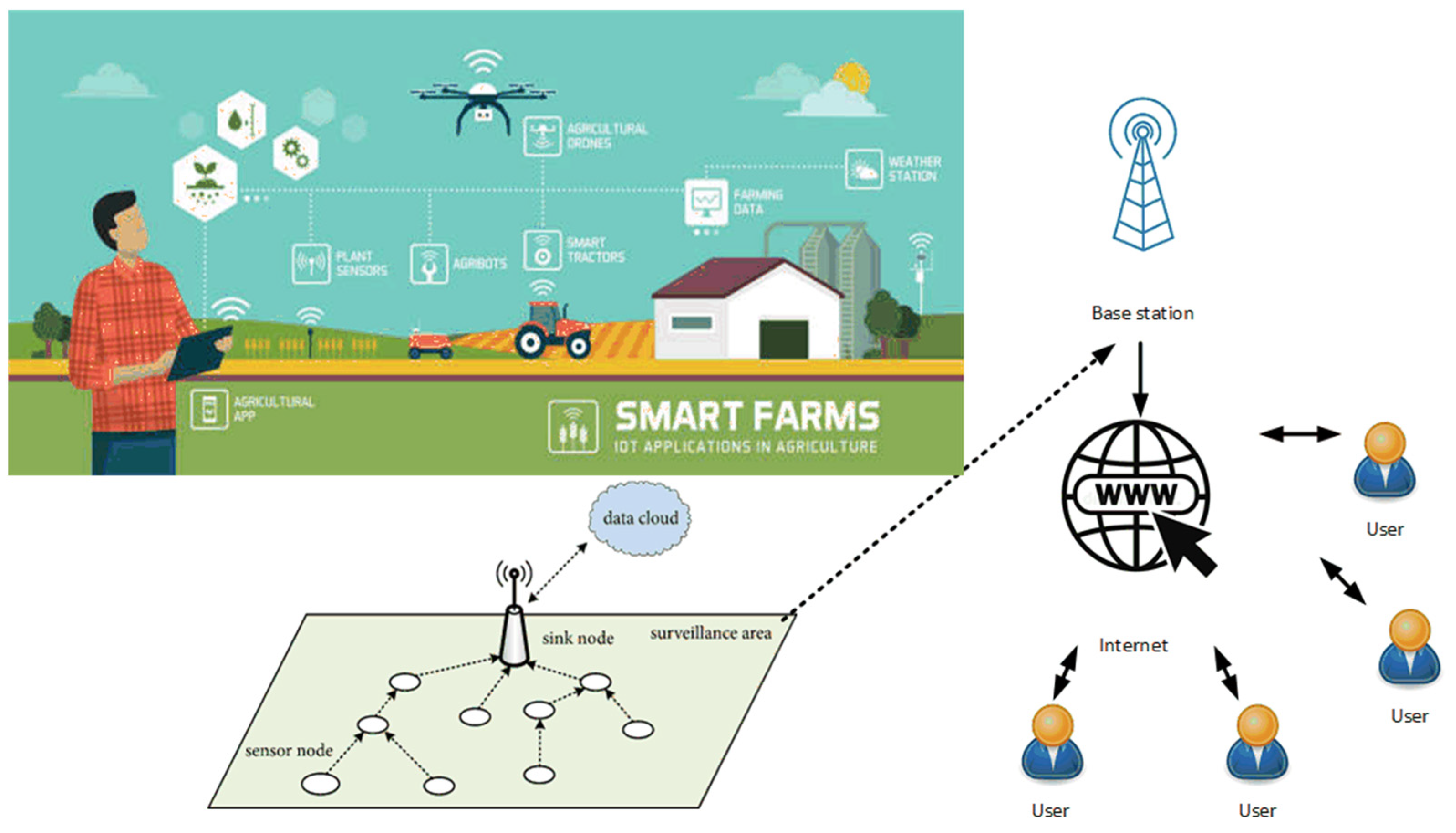
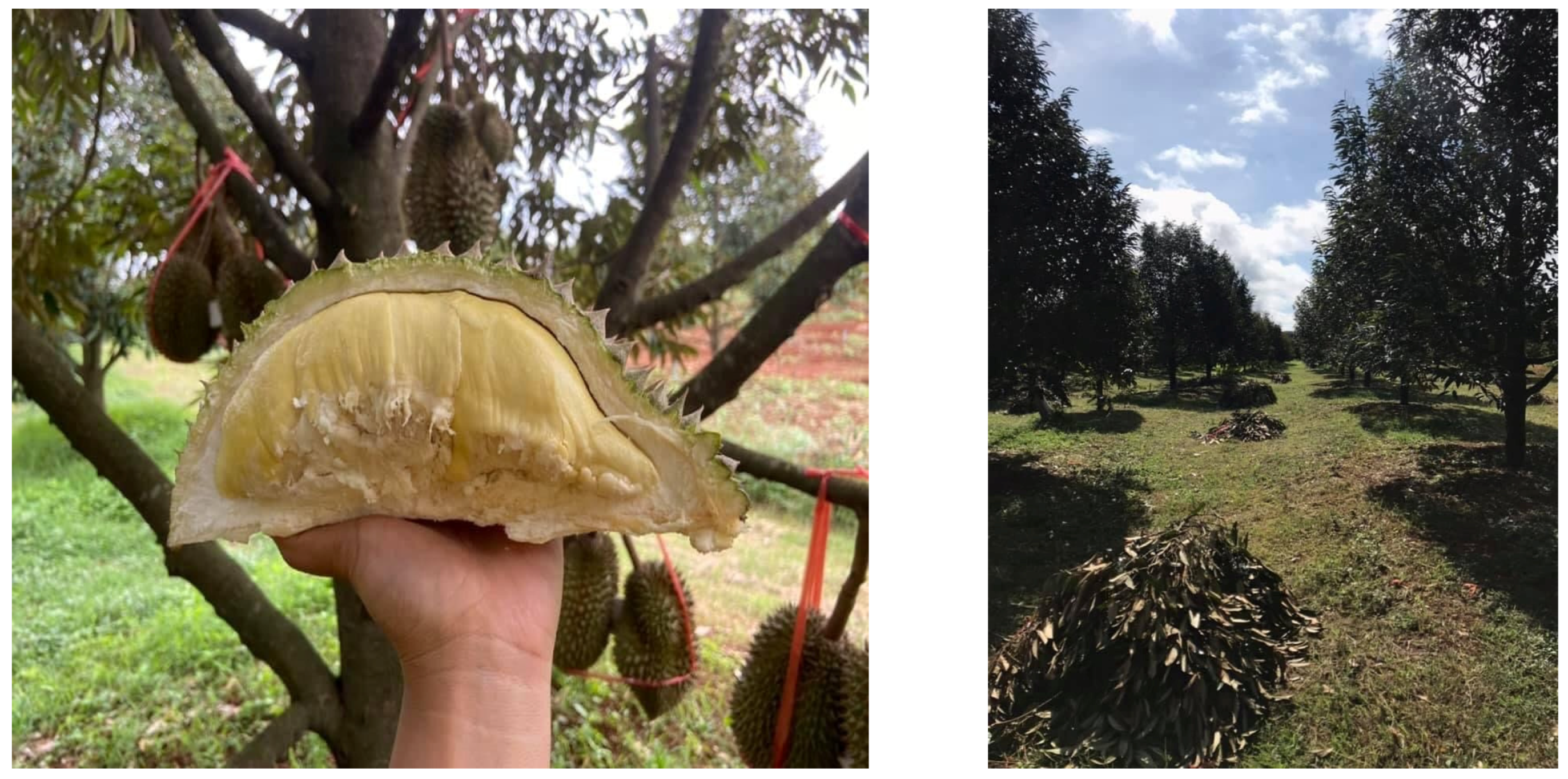
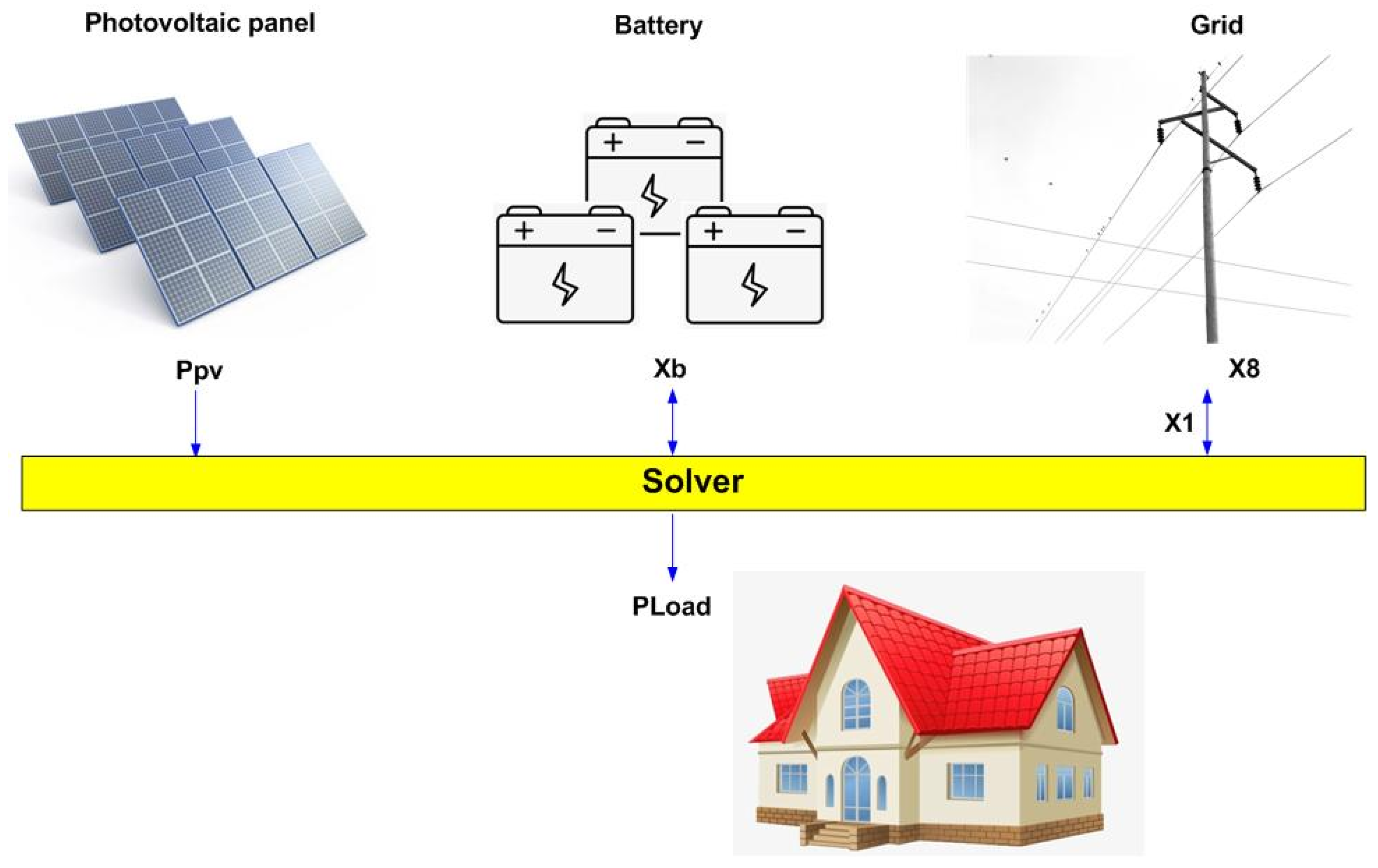
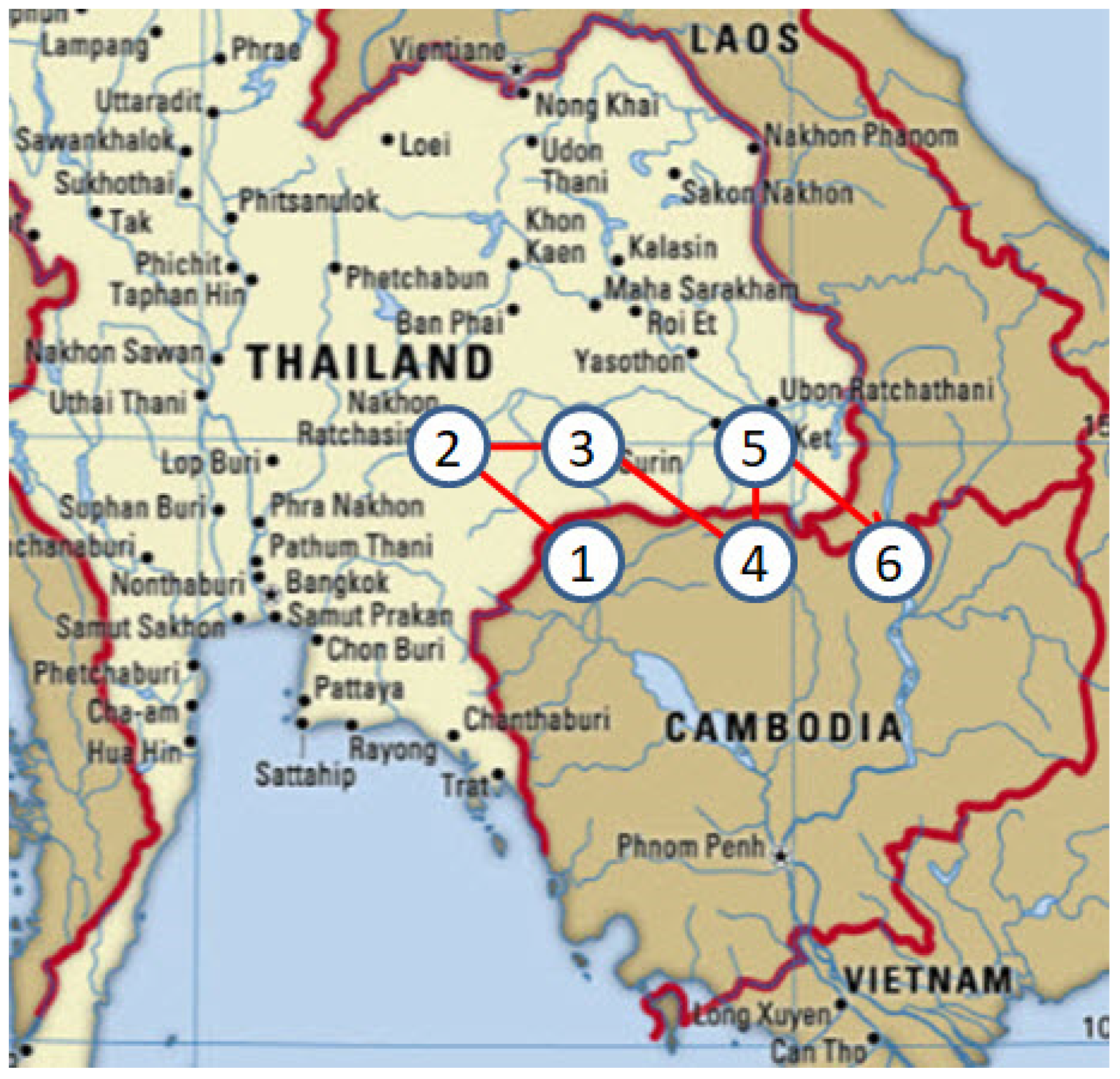
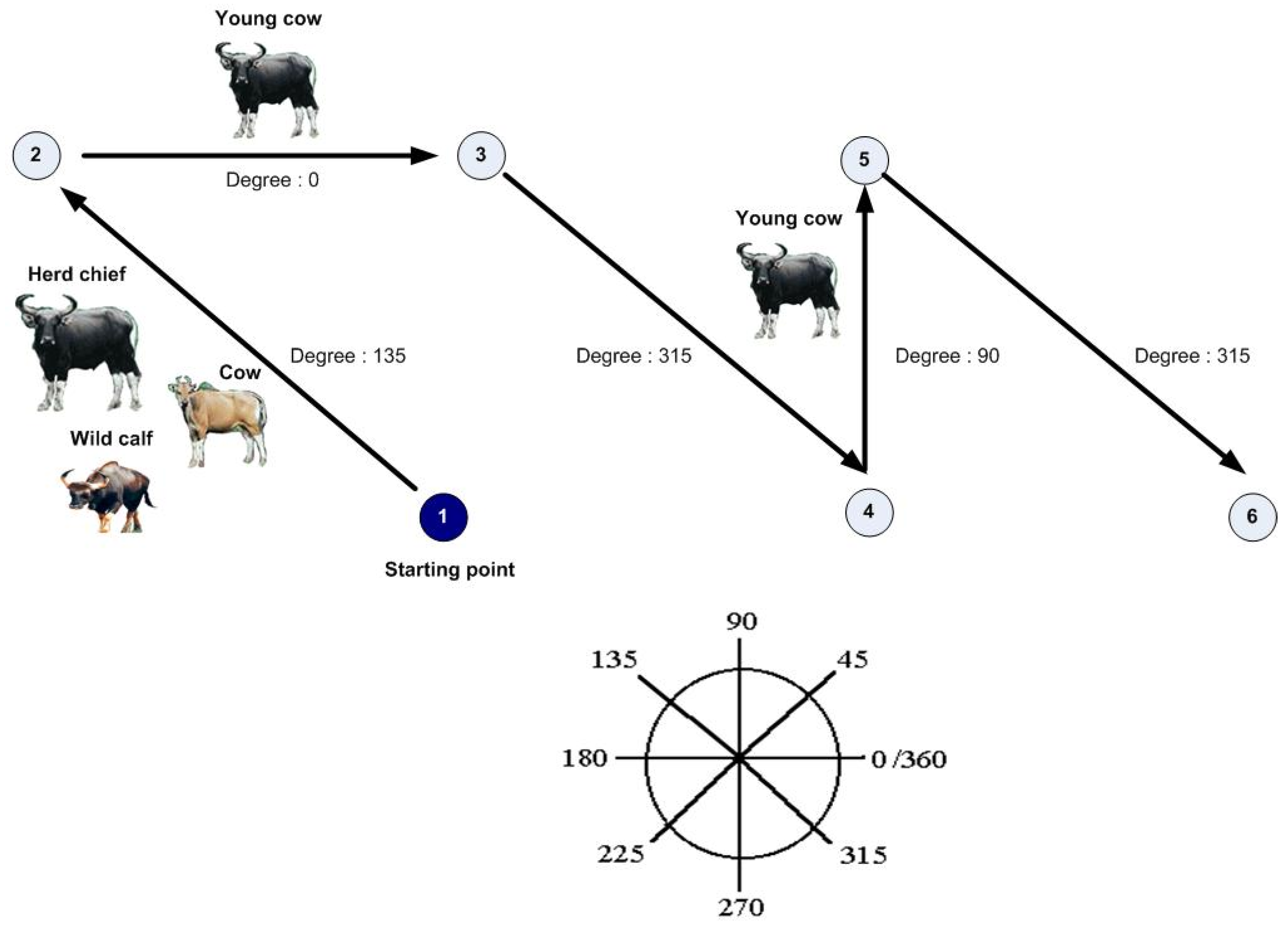
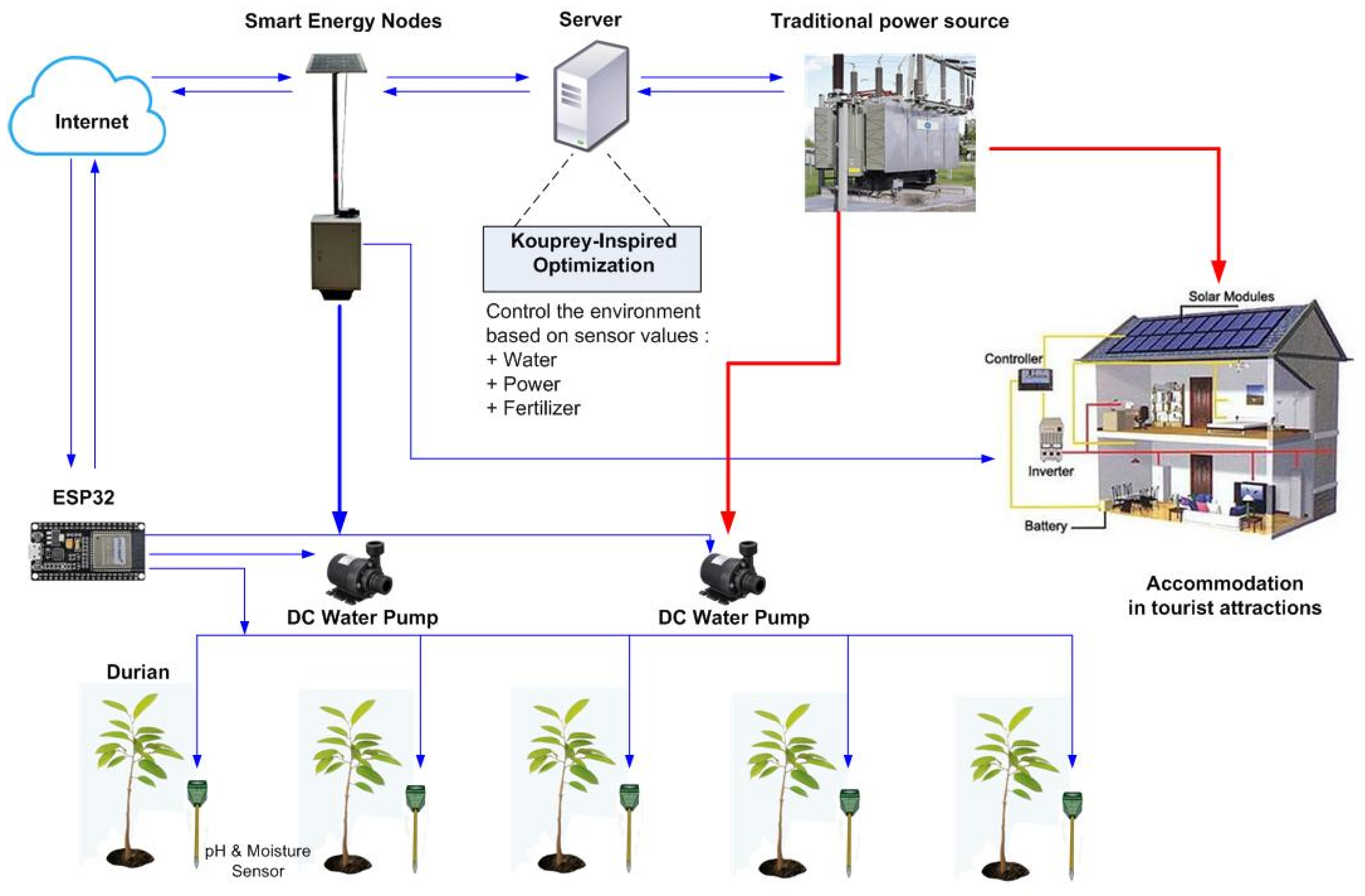

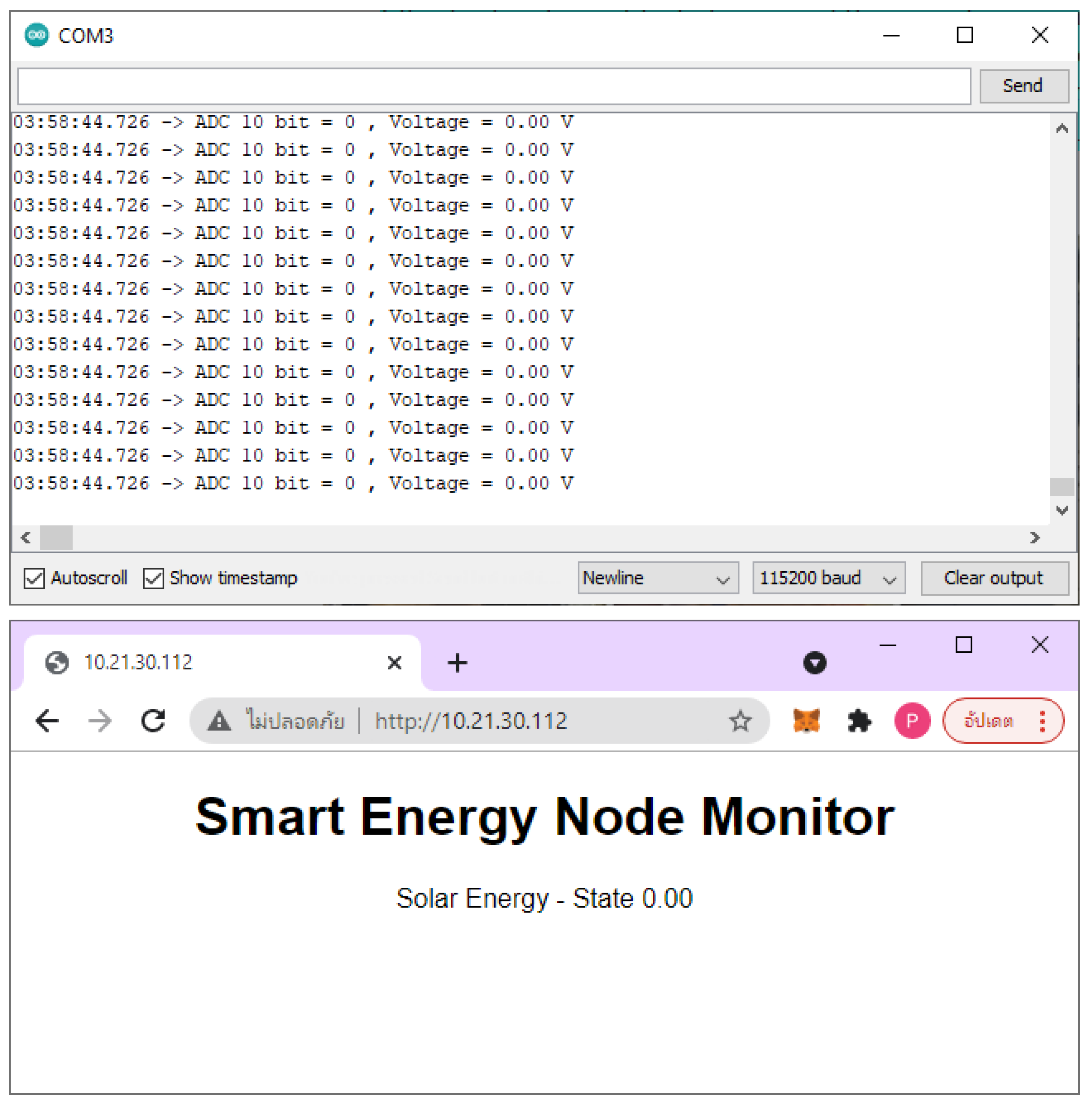
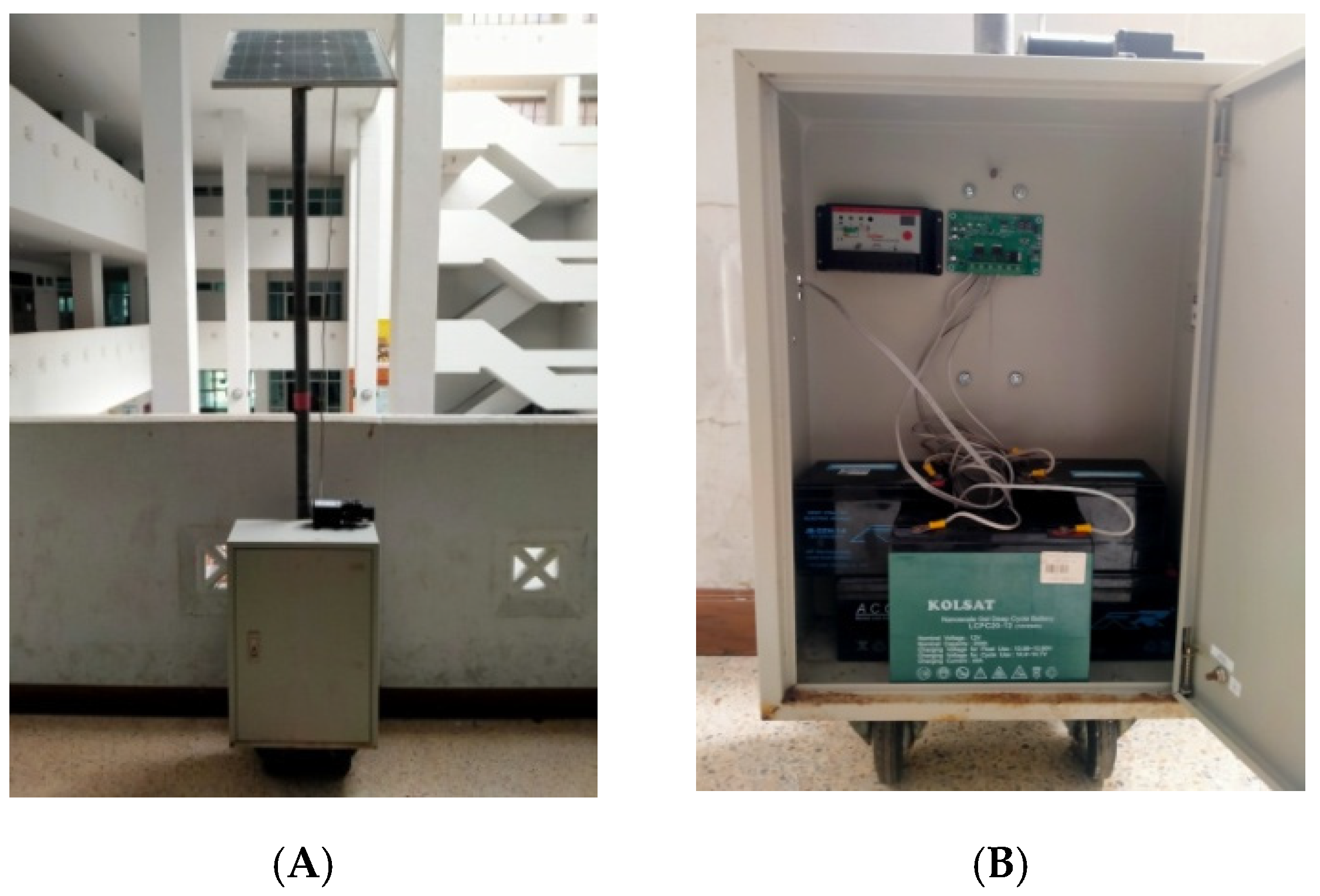
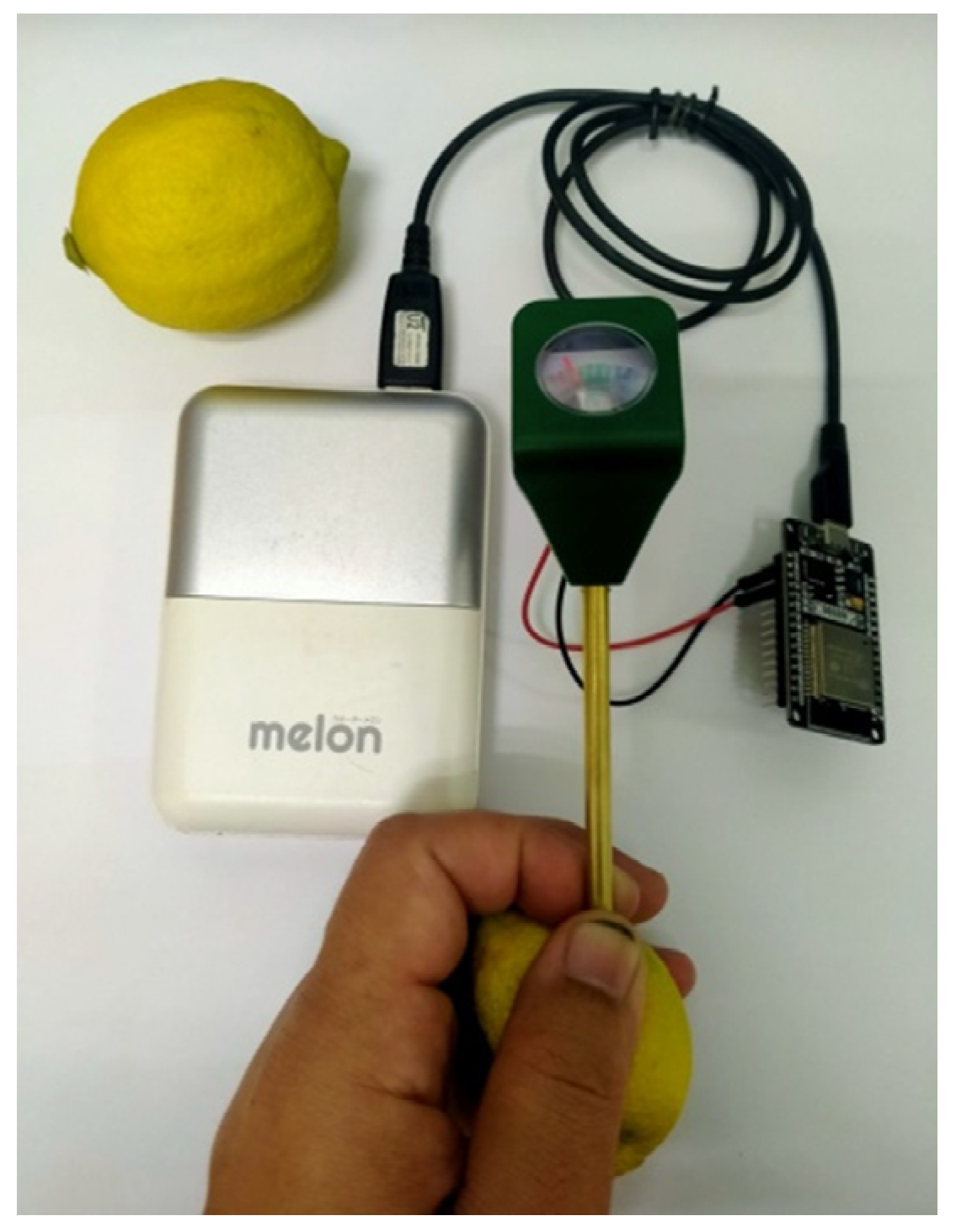
| Solar Panel Power Generation | ||||
|---|---|---|---|---|
| 1.5 kW | 3 kW | 5 kW | 10 kW | |
| Lower electricity bill | 850–1000 Baht | 1700–2000 Baht | 2550–3000 Baht | 5100–6000 Baht |
| Angle of the Solar Panel Placement | |||
|---|---|---|---|
| Period | 15 | 45 | 90 |
| 08:00 h. | 21.5 Volts | 21.2 Volts | 19.0 Volts |
| 13:00 h. | 21.8 Volts | 21.0 Volts | 20.0 Volts |
| 17:00 h. | 17.6 Volts | 17.3 Volts | 16.0 Volts |
| Sensor Values | Average |
|---|---|
| 1. Voltage | 21.8 |
| 2. Soil moisture level | 38% |
| 3. pH values | 6.0 |
| Variable | S.D. | |
|---|---|---|
| 1. Benefit of the system | ||
| 1.1 The system is important for searching for information to support their travel planning. | 4.17 | 0.54 |
| 1.2 The system is easy to access information. | 4.31 | 0.47 |
| 1.3 The system is a useful tool/ | 4.24 | 0.64 |
| 2. System’s design | ||
| 2.1 The color use is appropriate. | 4.21 | 0.82 |
| 2.2 The size of the font is easy to read. | 4.17 | 0.85 |
| 2.3 The buttons in the application are easy to use. | 4.21 | 0.68 |
| 2.4 The used images are clear and beautiful. | 4.31 | 0.81 |
| 3. Content | ||
| 3.1 The content is easy to understand. | 4.00 | 0.60 |
| 3.2 The content has the appropriate amount of data. | 4.14 | 0.69 |
| 4. Easy to use | ||
| 4.1 The system is easy to use. | 4.28 | 0.59 |
| 4.2 The system is a quick process. | 4.45 | 0.51 |
| 4.3 The buttons in the application are properly placed and easy to use. | 4.31 | 0.49 |
| 4.4 The links are accessible. | 4.21 | 0.67 |
| 5. The functionality of the system | ||
| 5.1 The system can be easily installed. | 4.10 | 0.77 |
| 5.2 The system is stable. | 4.14 | 0.52 |
| 6. Overall satisfaction and effectiveness | ||
| 6.1 The system should be recommended. | 4.21 | 0.62 |
| 6.2 The system is beneficial to the user. | 4.26 | 0.57 |
| 6.3 The system has effectiveness. | 4.00 | 0.60 |
| 6.4 Overall satisfaction. | 4.20 | 0.63 |
Publisher’s Note: MDPI stays neutral with regard to jurisdictional claims in published maps and institutional affiliations. |
© 2022 by the authors. Licensee MDPI, Basel, Switzerland. This article is an open access article distributed under the terms and conditions of the Creative Commons Attribution (CC BY) license (https://creativecommons.org/licenses/by/4.0/).
Share and Cite
Suanpang, P.; Pothipassa, P.; Jermsittiparsert, K.; Netwong, T. Integration of Kouprey-Inspired Optimization Algorithms with Smart Energy Nodes for Sustainable Energy Management of Agricultural Orchards. Energies 2022, 15, 2890. https://doi.org/10.3390/en15082890
Suanpang P, Pothipassa P, Jermsittiparsert K, Netwong T. Integration of Kouprey-Inspired Optimization Algorithms with Smart Energy Nodes for Sustainable Energy Management of Agricultural Orchards. Energies. 2022; 15(8):2890. https://doi.org/10.3390/en15082890
Chicago/Turabian StyleSuanpang, Pannee, Pattanaphong Pothipassa, Kittisak Jermsittiparsert, and Titiya Netwong. 2022. "Integration of Kouprey-Inspired Optimization Algorithms with Smart Energy Nodes for Sustainable Energy Management of Agricultural Orchards" Energies 15, no. 8: 2890. https://doi.org/10.3390/en15082890
APA StyleSuanpang, P., Pothipassa, P., Jermsittiparsert, K., & Netwong, T. (2022). Integration of Kouprey-Inspired Optimization Algorithms with Smart Energy Nodes for Sustainable Energy Management of Agricultural Orchards. Energies, 15(8), 2890. https://doi.org/10.3390/en15082890







